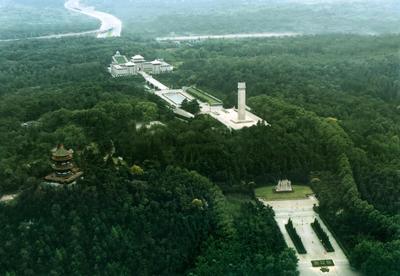盐城工业职业技术学院陈传亚
Yancheng NaturalReserves for the Rare Birds
Hello, everyone:
Here we are in Yancheng NaturalReserves for the Rare Birds. It was, approved by Jiangsu ProvincialPeoples Government, founded in November of 1983, and in 1992, itwas, approved by the state Council, upgraded as National Reservesand established as UNASCO Yancheng Biological Reserves , and listedin World Biological Reserves Network and brought into East AsiaCranes Reserve Network.
AUDIO &VEDIO ROOM Here in the room,we can get the information of the reserves with the help ofaudio& video tapes, pictures and samples.
There are quite a number of birds inthe reserves, with the red-crowned cranes under the majorprotection. A red-crowned cranes is, precious as a giant panda, sonamed as it has a piece of red feather like a crown on its top.There exist now only about 2000 wild red-crowned cranes in theworld, around 1000 of which fly to the reserves for winter everyyear.
Yancheng National Reserve for the RareBirds is the largest coastal reserves, it stretched over the tidalland in Dongtai, Dafeng, Sheyang, Binhai and Xiangshui, coveringsome 580 km. of the coastal line, with a total space of about453,000 ha., centering around 17,4000 ha. Of the reclaimed landbetween Xinyang Port and Doulong Port.
In the tidal land, are living 450 kindsof plants, 379 kinds of birds, 45 kinds of amphibians, 281 kinds offishes and 47 kinds of mammals, among which are 12 kinds of thewild lives under the Class I protection, like the red-crownedcranes, white cranes, storks, wild ducks, sea-gulls, bustardvulture, etc., and 67 kinds of the wild lives are under the ClassII protection. In addition, the tidal land yields over 50,000 tonsof reed, 1,000,000 tons of aquatic produces, and about 300 tons ofclam worms each year.
The reserve is the resting place forthe birds migrating from Northeast Asia to Australia, and it isalso an important habitat for waterfowels to live through winter.Every year over3, 000,000 various birds migrate by way of Yancheng.It is one of the places which reserve and provide refuge for quitea few living species on the brink of extinction, and 229 kinds ofbirds living in the reserves are listed in the Red-covered Book ofthe Endangering Species by World Natural Reserves ProtectionUnion.
OSTRICH GARDENS 2 ostrich gardens havebeen built up in the reserves, one is near Wanheting Pagoda,another is by Xinyang Town. Over 200 ostriches, originated fromAfrica, are raised in the gardens. Any visitor who has an interestto enjoy an ostrich ride may have a try. Actually, it is acourageous sport, re quiring both valor and skill, for the rider hasnothing but the long neck to hold on in the ride.
DAVID-DEER GARDEN This reserve is aparadise, not only for the red-crowned cranes but also for theDavid-deer, which are introduced from the abroad. Every Autumn, alarge stretches of the salt-wort growing up like pieces of the rosyclouds, with the strong David-deers galloping among the salt-wortagainst the background of the white expands of the tidal land,that’s really beautiful. And in the reserves also lives a kind ofrare animals, called long-teeth deers, or, river-deers, totaledabout 1000. It is big as a dog, with 2 long teeth and beautifulcolor-spotted fur, but with no horns. A river-deer runs so fastthat people can seldom catch a sight of it. The natural enemy forthe river-deer is the badger, which looks like a small panda. It isa carnivore, good at digging holes.
CRANE GIRL TOMB. 2 km. northeast toWanheting Pagoda is a pine forest, lush and green, among which liesa large tomb of Crane Grirl, Xu Xiu-juan, who gave up her life forsaving the rare birds. Xu was ,born in 1964, of Man nationality.She was awarded as the Model Tourist Worker for training cranes. At21, she entered Northeast Forestry University , at which shestudied so hard that within one year and half she finished all thecourses. In 1986, she was employed to domesticate the red-crownedcranes in the reserves, and succeeded in hatching the cranes byartificial incubation the same year. She contributed a lot to solvethe difficult problem to make it possible for the red-crownedcranes in the reserves not to migrate every year. On Sep. 16, 1987,Xu, looking for the lost swan for 2 days in the white expanse ofthe tidal land, gave up her young life in crossing a river. Tomemorize her heroic deeds, 2 statues of Xu was made in the reserves, one is standing in front of the office building , another is setat the entrance of the reserves. And a TV opera, Crane Soul , iscreated to reproduce her short life of glamour, its theme song, ATrue Story, with the beautiful melody, touching people deep in theheart, is resounded on both banks of the Yangtze.
RISING-SUN ON YELLOW SEA It is the besttime to see the spectacular of the sun rising from the Yellow Seain Xin-yang Port on the 8th and 23d every lunar month,when a high tide appears in the early morning. At dawn, day breakswith a strip of light skimming over the surface of the sea, turningfrom delicate red to scarlet. Above the tide, a red spot appearswith the rosy cloud, which is , in turn, getting larger andbrighter, shaping like an egg yolk with a delicate yellow colorpervading in, that is the early rising sun. Soon, it rises highabove in the sky, shining over the world.

BEACH DISCO To their hearts content,the visitors can aboard a ship sailing on the sea. When the tideebbs, they can, taking off the shoes, dance disco on the softbeach, it’s a particular pleasure. The so-called beach disco is totread on the beach to seek shellfish. The beach is so soft andflat, which is spotted with numerous small holes, in each holelives a shellfish. When man stamps lightly around the hole, theshellfish will emerges from the sand. Actually , there is much fun,making visitors enjoy themselves so much as to forget to gohome.
So much for my narration.
Thank for your attention.
 爱华网
爱华网


